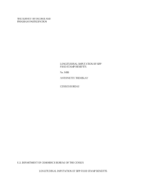Longitudinal Imputation of SIPP Food Stamp Benefits
Longitudinal Imputation of SIPP Food Stamp Benefits
This paper reports the general results of research undertaken by Census Bureau staff. The views expressed are attributable to the author and do not necessarily reflect those of the Census Bureau.
Introduction
"As analysis, good imputation methods can improve naive estimates based on complete or available cases - but bad imputation methods can make matters worse." (Little and Su 1989)
The primary product of the Survey of Income and Program Participation (SIPP) of the Bureau of the Census is longitudinal data. Basically, SIPP collects detailed information on income and wealth, providing a tool for managing and evaluating government transfer and service programs. Data collection results in over a thousand items relating to the economic situation of persons, families, and households in the United States. The survey uses a rotating panel design, with a new panel of sample households being introduced at the start of each calendar year. The sample persons of these households are interviewed eight times, at four month intervals, over a two and a half year period. Each round of interviews for a panel (i.e., four months) is designated a wave (Census 1991). When item nonresponse occurs on a given wave(s), due to answer refusal, data editing, or omission during the interview, it is desirable to make use of data from other waves in the imputation process. This data could come from surrounding waves of the same household/person(s) that exhibit the missing value or from other households. Since this longitudinal information may be highly correlated with the missing value, a reduction of nonresponse bias and an improvement of precision may be realized.
This research examines the current and three alternative longitudinal imputation methods as applied to the SIPP item of food stamp income. The basis of the research is the first four waves of the 1990 SIPP panel. This panel consists of approximately 21,900 interviewed households. Although the most current wave item nonresponse rates (1988 SIPP panel) indicate a relatively low range of 5-8% for food stamp income, it is deemed worthy to be the continuous variable of interest for several reasons. Eight percent of the 1990 total population received food stamp benefits (i.e., 20 million participants) amounting to almost 18 billion dollars of federal, state and local expenditures (U.S. House of Rep. 1992). Also, computer programming for this research is eased considerably since food stamp income can be treated as a household-level variable, as is done operationally.
The primary evaluation criterion is the accuracy of the imputations; that is, the comparison of the actual and the imputed values. A framework is provided for the application of the methodologies of this research to other SIPP items, with higher nonresponse rates.
Others in Series
Working Paper
Working Paper
Working Paper




